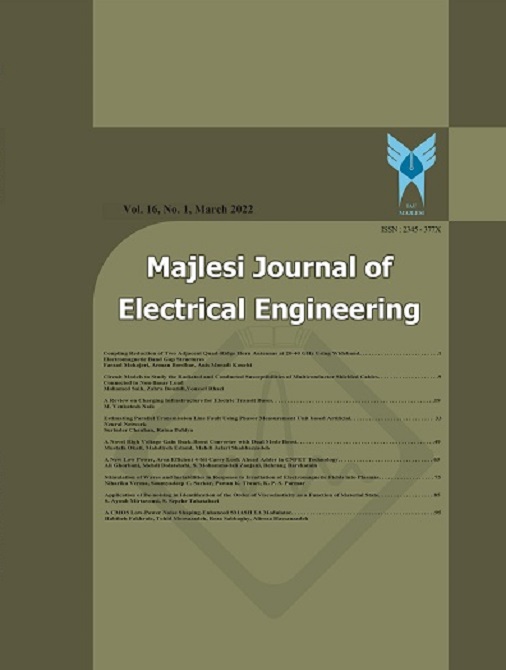Document Type : Reseach Article
Abstract
This paper aims to investigate the performance of a bidirectional DC-DC converter utilizing an ANFIS-PID controller in closed-loop mode. This is because operating a bidirectional DC-DC converter in open-loop mode can result in several problems, including poor regulation, limited flexibility, and limited performance, especially in transient response and efficiency. Additionally, there is a risk of overloading the converter or damaging connected devices due to uncontrolled
operation. Therefore, the main objective of this study is to address the critical requirement for enhanced response and load efficiency within the context of a three-phase interleaved bidirectional DC-DC converter designed for Hybrid Electric Vehicle (HEV) applications with 1 kW rated power of converter and 10 kHz switching frequency which exhibits 14.29% reduce overshoot in the system. This research aims to utilize the capabilities of an ANFIS-PID controller to optimize the
dynamic responsiveness and load efficiency of the converter. The findings of the study reveal that the implementation of an ANFIS-PID controller leads to improved transient response and load efficiency, highlighting its potential to enhance bidirectional DC-DC converters. To design and simulate the behavior of the converter, MATLAB/Simulink software has been employed.
Keywords
role of electric vehicles in near-term mitigation
pathways and achieving the UK ’s carbon budget.”.
Appl. Energy, 251:pp. 113111, 2018.
[2] P. Wang, C. Zhao, Y. Zhang, J. Li, and Y. Gao. “A
bidirectional three-level DC-DC converter with a
wide voltage conversion range for hybrid energy
source electric vehicles.”. J. Power Electron, 17(2):
pp. 334–345, 2017.
[3] S. Omer A. Dik and R. Boukhanouf. “Electric vehicles: V2G for rapid, safe, and green EV penetration. ”. Energies, 15(803):pp. 2–27, 2022.
[4] J. Chen and B. Lin. “Implementation of digital bidirectional buck- boost converter with changeable
output voltage for electric vehicles.”. IEEE International Future Energy Electronics Conference (IFEEC),
:pp. 1–6, 2021.
[5] F. S. M. Alkhafaji, W. Z. W. Hasan, M. M. Isa, and
N. Sulaiman. “A novel method for tuning PID controller.”. J. Telecommun. Electron. Comput. Eng, 10
(1):pp. 33–38, 2018.
[6] E. Aircrafts, A. Ojeda-rodr ´ ´ıguez, P. Gonzalez-vizuete, ´
and J. Bernal-mendez. “ ´ A survey on bidirectional
dc/dc power converter topologies for the future
hybrid and all electric aircrafts.”. Energies, 13(18),
2020.
[7] M. Bharathidasan, V. Indragandhi, and B. Aljafari.
“Hybrid controlled multi-input dc/dc converter for
electric vehicle application.”. Int. Trans. Electr. Energy Syst, 2023, 2023.
[8] S. Ghosh. “Neuro-fuzzy-based IoT assisted power
monitoring system for smart grid.”. IEEE Access, 9:
pp. 168587–599, 2021.
[9] K. Bendaoud et al. “Implementation of fuzzy logic
controller (FLC) for DC-DC boost converter using
Matlab/Simulink.”. Journal of Sensors and Sensor
Networks. Special Issue: Smart Cities Using a Wireless Sensor Networks, :pp. 1–5, 2017.
[10] K. Mumtha, V. Mahalakshmi, and S. Usha Devi.
“Proposed fuzzy logic controller for Buck DC-DC
converter.”. Int. J. Fuzzy Syst. Adv. Appl, 7:pp. 24–28,
2021.
[11] F. Wang, B. Su Y. Wang, and C. Teng. “Three-phase
interleaved high step-up bidirectional DC-DC converter.”. IET Power Electron, 13(12):pp. 2638–2650,
2020.
[12] M. H. Jali, N. E. S. Mustafa, T. A. Izzuddin, R. Ghazali, and H. I. Jaafar. “ANFIS-PID controller for arm
rehabilitation device.”. Int. J. Eng. Technol, 7(5):pp.
1589–1597, 2015.
[13] U. A. Shaikh, M. K. AlGhamdi, and H. A. AlZaher. “Novel product ANFIS-PID hybrid controller
for buck converters.”. J. Eng, 2018(8):pp. 730–734,
2018.
[14] C. Lai, Y. Lin, and D. Lee. “Study and implementation of a two-phase interleaved bidirectional dc/dc
converter for vehicle and dc-microgrid systems.”.
Energies, 8(9):pp. 9969–9991,, 2015.
[15] R. Kumar, P. K. Behera, and M. Pattnaik. “A comparative analysis of two-phase and three-phase interleaved bidirectional dc-dc converter.”. IEEE Int. Students’ Conf. Electr. Electron. Comput. Sci. SCEECS, :
pp. 1–5, 2023.
[16] S. Dusmez, S. Member, A. Hasanzadeh, and A. Khaligh. “Comparative analysis of bidirectional thre
-level DC-DC converter for automotive applications.”. IEEE Trans. Ind. Electron, , 2015.[17] M. H. Almawlawe and I. Dahham. “Controlling
switched DC-DC converter using ANFIS in comparison with PID controller.”. IOP Conference Series: Materials Science and Engineering, , 2020.
[18] A. F. Algamluoli. “Voltage controller of dc-dc buck
boost converter with proposed PID controller.”. Int.
J. Adv. Res. Comput. Eng. Technol, 9(1), 2020.
[19] R. Mechgoug, N. Tkouti, and F. Okba. “A adaptive
neuro-fuzzy inference system (ANFIS) controller
for a 9-level inverter for grid-connected PV systems.”. Neuro Quantology, 21(6):pp. 1120–1134,
2023.
[20] T. S. Babu. “A comprehensive review of hybrid energy storage systems: converter topologies, control
strategies and future prospects.”. IEEE Access, 8,
2020

